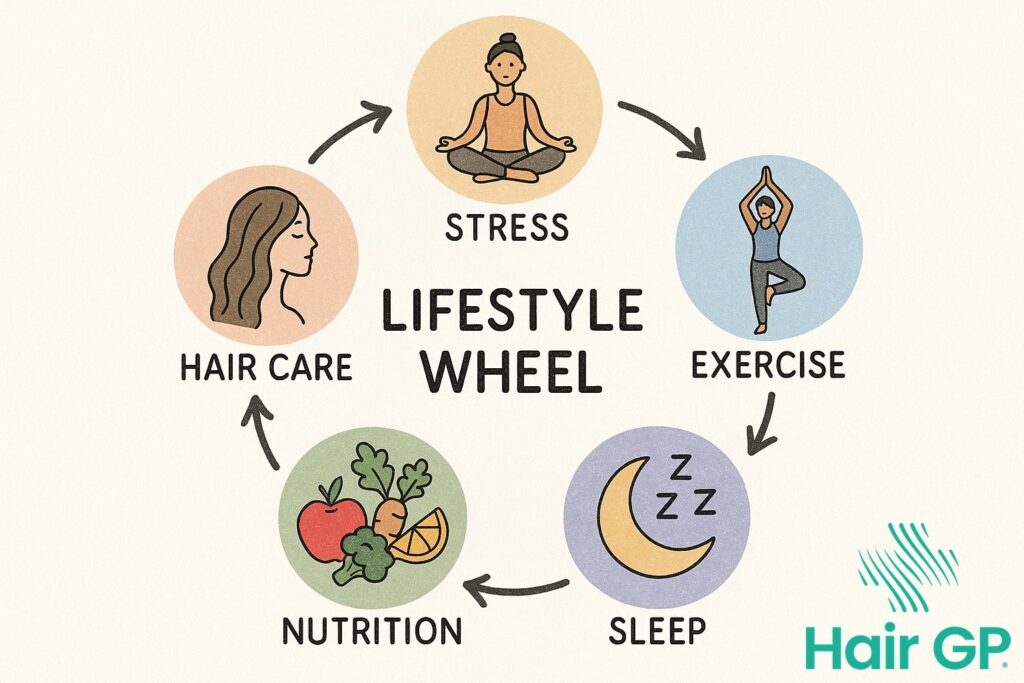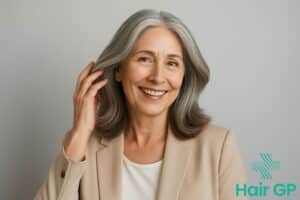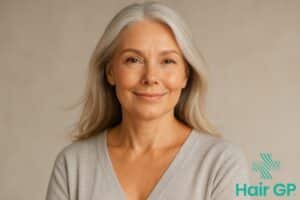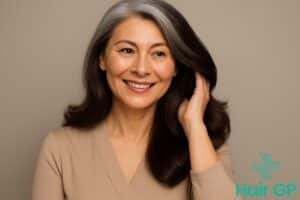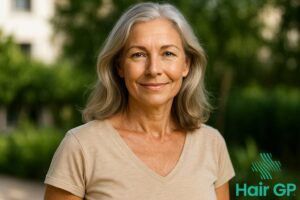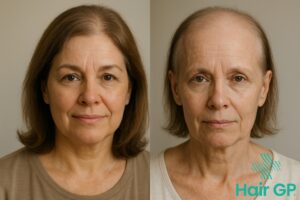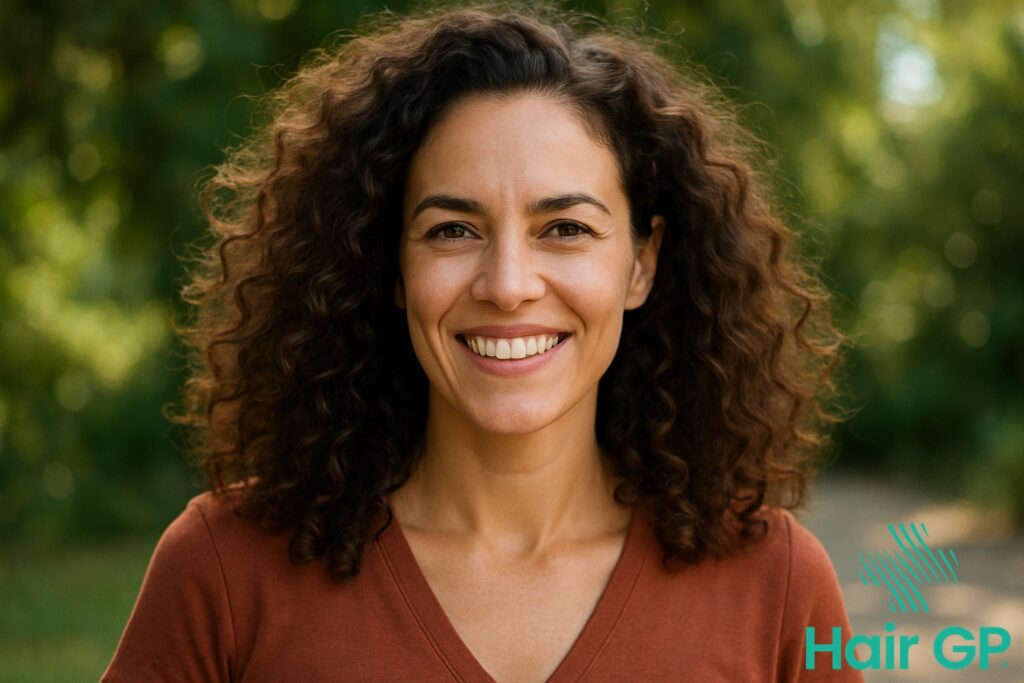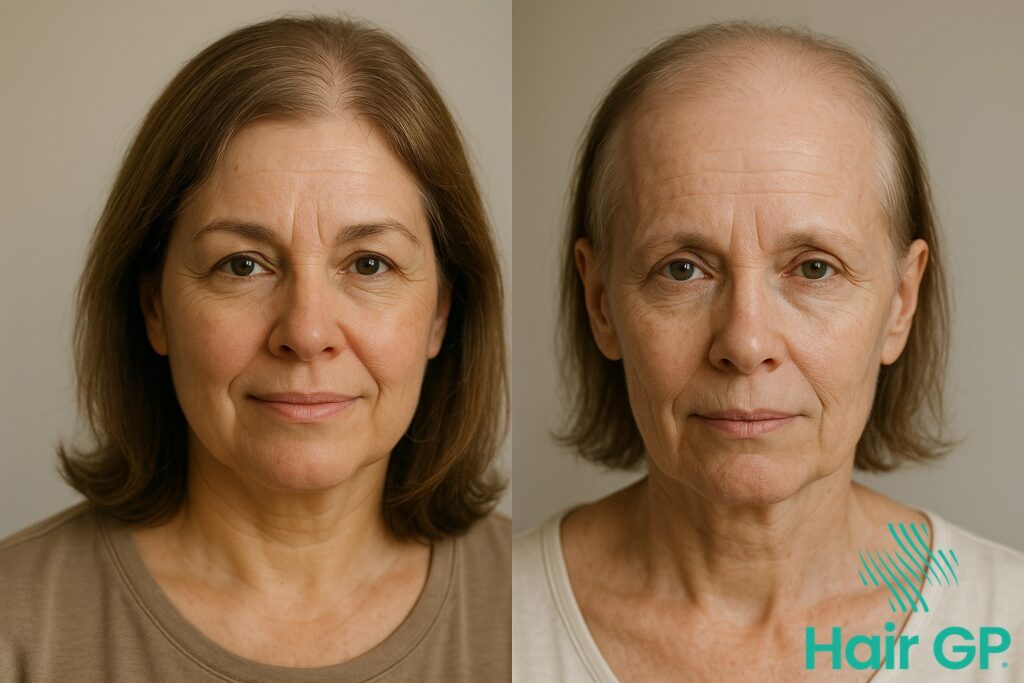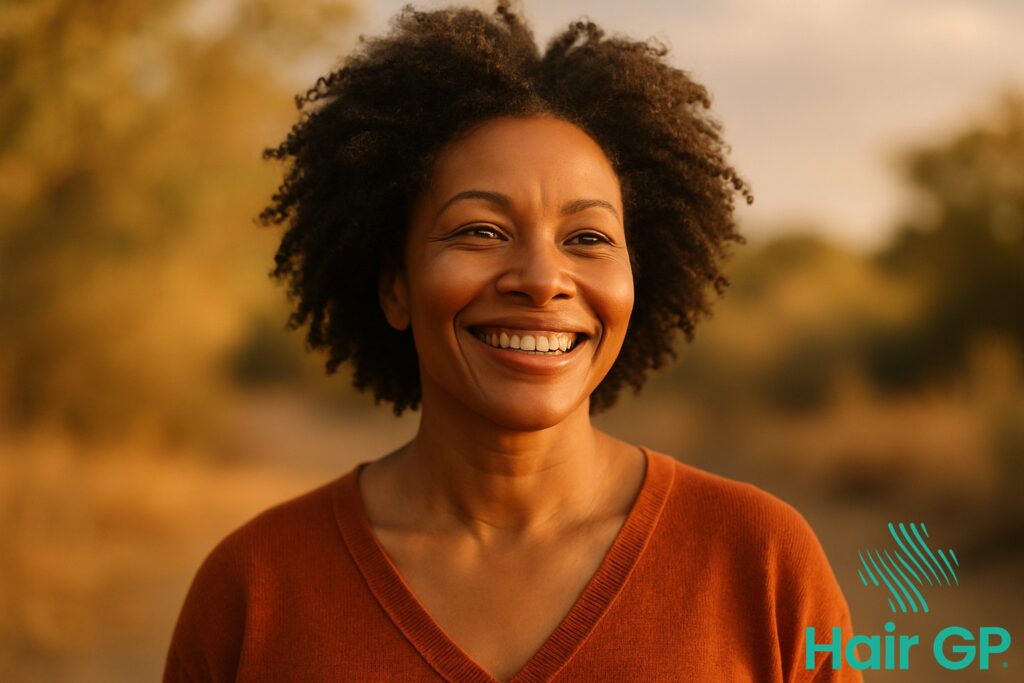Introduction
For many women approaching or experiencing menopause, changes in hair health can be one of the most distressing symptoms. Menopausal hair loss affects up to 40% of women during this transition, yet it remains an under-discussed aspect of women’s health. Unlike temporary hair shedding, hormonal hair loss during menopause involves complex changes to the hair growth cycle that require a strategic, phased approach to manage effectively.
As oestrogen levels decline during perimenopause and beyond, many women notice their hair becoming thinner, particularly at the crown and along the parting. This female pattern hair loss differs from typical ageing-related changes and stems from shifting hormone balances that affect how hair follicles function. Understanding these mechanisms is crucial for developing an effective management strategy.
This comprehensive guide presents a three-phase approach to managing hair health throughout the menopausal transition. You’ll discover how hormonal changes impact your hair, learn phase-specific strategies from early perimenopause through post-menopause, and explore evidence-based treatments ranging from essential nutrients to professional interventions. We’ll examine lifestyle factors that influence hair health, natural remedies that complement conventional approaches, and how to create personalised care routines for your unique needs.
Whether you’re noticing the first signs of thinning or seeking to rebuild hair density after menopause, this guide provides practical tools for tracking progress and avoiding common pitfalls. By understanding and working with your body’s changes rather than against them, you can maintain healthier, fuller hair throughout this natural life transition.
Key Takeaways – TL/DR
- Menopause affects hair in three distinct phases: Early (perimenopause), Peak (menopause transition), and Recovery (post-menopause)
- Each phase requires different strategies targeting hormonal changes, nutrition, and hair care routines
- Up to 50% of women experience significant hair loss during menopause, but targeted interventions can minimize impact
- Early intervention during perimenopause can prevent severe hair loss in later phases
- Recovery phase focuses on rebuilding hair density and maintaining long-term hair health
Understanding Menopause and Hair Health
The biological mechanisms underlying menopausal hair changes involve complex hormonal shifts that fundamentally alter the hair growth cycle and follicle function. Understanding these changes provides essential insight into why hair thinning occurs during this transition and helps inform effective management strategies. The interplay between declining oestrogen levels and relative androgen dominance creates a cascade of effects that transform hair quality, density, and growth patterns.
Hormonal Changes Affecting Hair
During menopause, oestrogen levels can decline by up to 60% within the first two years of the menopausal transition[1], removing a crucial protective factor for hair follicles. Oestrogen plays a vital role in maintaining the anagen phase and promoting hair thickness by increasing the production of growth factors and improving scalp circulation. As these protective effects diminish, hair follicles become increasingly vulnerable to androgen-related damage.
The relative increase in androgen activity, particularly dihydrotestosterone (DHT), becomes more pronounced as oestrogen levels fall. This shift doesn’t necessarily mean androgen levels increase; rather, the protective buffer of oestrogen disappears, allowing androgens to exert greater influence on hair follicles. DHT binds to androgen receptors in susceptible follicles, triggering a process called miniaturisation where follicles progressively shrink and produce thinner, shorter hairs. This mechanism underlies the development of female pattern baldness, also known as androgenetic alopecia, which affects approximately 40% of women by age 50[2].
The Hair Growth Cycle Disruption
The normal hair growth cycle consists of three primary phases: anagen (growth), catagen (transition), and telogen (resting). Under optimal conditions, the anagen phase typically lasts 2-7 years, whilst the telogen phase spans approximately 3 months. However, hormonal hair loss during menopause dramatically alters these timelines, creating significant changes in hair density and appearance.
Menopausal hormonal changes shorten the anagen phase whilst simultaneously extending the telogen phase, resulting in more follicles resting and fewer actively growing at any given time. This disruption means hairs spend less time growing and more time in the shedding phase, leading to progressive thinning. Additionally, when follicles do re-enter the growth phase, they often produce finer, shorter hairs with reduced pigmentation.
The cumulative effect of these hair growth cycle disruptions manifests as diffuse thinning, particularly noticeable at the crown and along the centre parting. Unlike temporary stress-related shedding, these changes represent a fundamental alteration in follicle behaviour that requires targeted intervention to address effectively. Understanding these biological mechanisms empowers women to seek appropriate treatments that target the underlying hormonal and follicular changes rather than merely addressing surface symptoms.
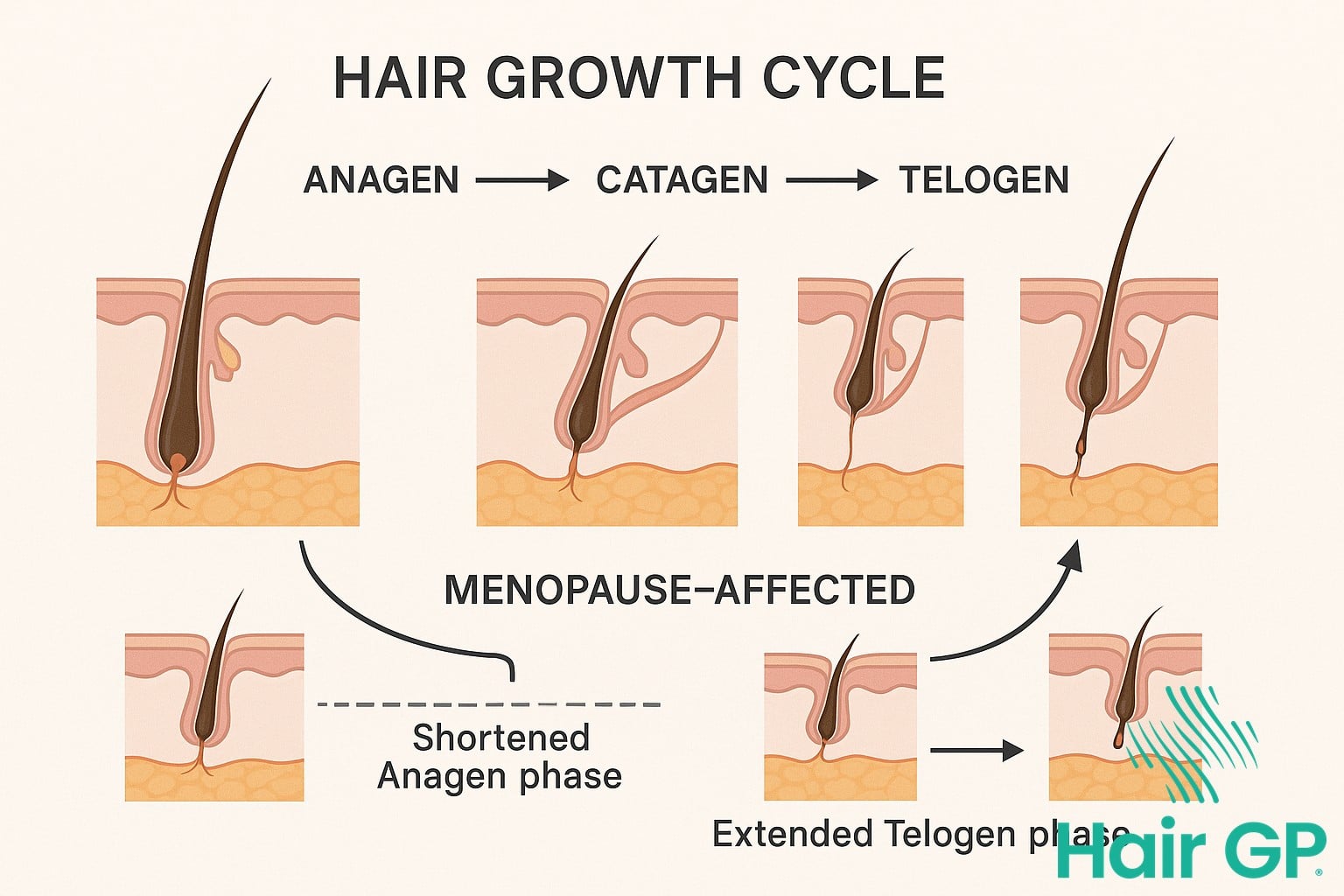
Phase 1: Early Menopause Hair Strategy (Perimenopause)
During perimenopause, proactive hair care strategies can significantly influence how your hair responds to hormonal fluctuations. This transitional phase offers a crucial window to implement preventive measures that support hair health before more pronounced changes occur. By recognising early warning signs and establishing targeted care routines, you can effectively maintain healthy hair throughout this hormonal shift.
Recognising Early Signs
The earliest indicators of hair changes during perimenopause often appear subtly, making them easy to overlook or attribute to other factors. Increased shedding typically manifests as more hair collecting in your brush or shower drain than usual. While losing 50-100 hairs daily is normal, women experiencing hair loss during perimenopause may notice this number gradually increasing.
Texture changes represent another hallmark of perimenopausal hair transitions. Previously smooth strands may develop a coarser, more wiry quality, whilst naturally curly hair might lose its definition. These alterations occur as declining oestrogen levels affect the hair follicle’s ability to produce consistent strand quality.
A slower growth rate becomes apparent when the time between salon visits for trims extends noticeably. Hair that once grew half an inch monthly may slow to a quarter inch or less. This deceleration results from shortened anagen (growth) phases as hormonal balance shifts. Recognising these early signs enables timely intervention to prevent hair loss from progressing.
Nutritional Foundation
Establishing robust nutritional support forms the cornerstone of maintaining hair health during perimenopause. Protein requirements increase during this phase, as hair consists primarily of keratin, a structural protein. Aim for 0.8-1 gram of protein per kilogram of body weight daily, incorporating lean meats, fish, eggs, legumes, and dairy products[1].
Iron deficiency frequently contributes to hair thinning in perimenopausal women, particularly those experiencing heavier periods. Include iron-rich foods such as spinach, lentils, and lean red meat, paired with vitamin C sources to enhance absorption. B vitamins, especially biotin, B12, and folate, support cellular metabolism within hair follicles. Wholegrains, leafy greens, and fortified cereals provide these essential nutrients.
Omega-3 fatty acids nourish the scalp and support healthy follicle function. Incorporate fatty fish like salmon and mackerel twice weekly, or consider plant-based sources including walnuts, chia seeds, and flaxseeds. These healthy fats help reduce scalp inflammation that can impede hair growth[2]. Adequate hydration, aiming for 8-10 glasses of water daily, ensures nutrients reach hair follicles effectively.
Preventive Hair Care Routine
Transitioning to gentler hair care practices during perimenopause helps minimise damage whilst supporting natural growth cycles. Sulphate-free products preserve the scalp’s natural oils, preventing dryness that can exacerbate hair thinning. Look for shampoos containing mild cleansing agents like cocamidopropyl betaine or decyl glucoside.
Scalp massage techniques stimulate blood circulation, delivering nutrients to follicles more efficiently. Using fingertips, apply gentle circular pressure across the scalp for 5-10 minutes daily. This practice can be enhanced with natural oils like rosemary or peppermint, diluted in a carrier oil, which may support follicle health.
Heat styling reduction proves crucial for maintaining hair integrity during perimenopause. When hair becomes more fragile, excessive heat accelerates breakage and moisture loss. Limit hot tool use to twice weekly maximum, always applying heat protectant spray beforehand. Embrace air-drying methods and heat-free styling techniques like braiding damp hair for waves. However this is a balance as letting it air dry can cause seborrheic dermatitis and fungal overgrowth so a cool heat setting is best.
Consider protective hairstyles that minimise tension on follicles. Loose ponytails, soft scrunchies instead of elastic bands, and avoiding tight braids help prevent traction-related damage. Sleep on silk or satin pillowcases to reduce friction that can cause breakage. These preventive measures, implemented consistently during early perimenopause, create optimal conditions for maintaining hair health throughout the menopausal transition.
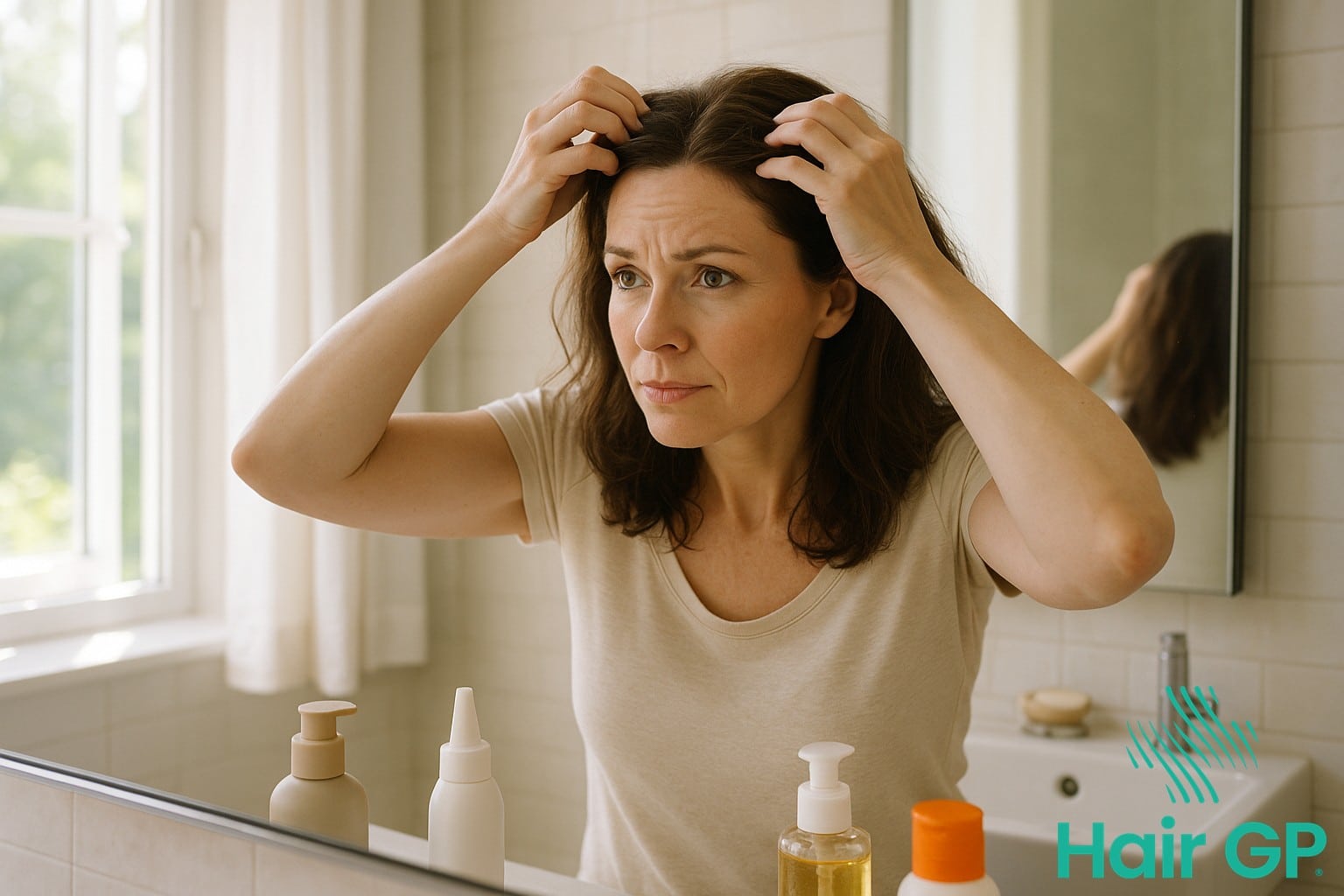
Phase 2: Peak Menopause Hair Strategy
The peak menopause phase presents the most challenging period for hair health, when hormonal fluctuations reach their zenith and significant hair loss often becomes most apparent. This critical stage demands intensive intervention strategies that combine medical treatments, specialised hair care techniques, and comprehensive psychological support to address both the physical changes and emotional impact of visible hair thinning.
Medical Interventions
During peak menopause, evidence-based medical treatments become essential for managing accelerated hair loss. Topical minoxidil remains the gold standard treatment, with studies demonstrating its effectiveness in promoting hair regrowth amongst menopausal women [3]. Available in 2% and 5% formulations, minoxidil works by prolonging the anagen phase of hair follicles and increasing follicular diameter, resulting in thicker, more robust hair growth. Women typically observe initial improvements within three to four months of consistent application, though maximum benefits may require six to twelve months of continuous use.
Hormone replacement therapy (HRT) offers another powerful intervention for menopausal hair loss, particularly when systemic symptoms accompany hair changes. Research indicates that oestrogen supplementation can help counteract the relative androgen excess that contributes to female pattern hair loss [4]. Combined oestrogen-progesterone therapies may provide superior benefits compared to oestrogen alone, as they help maintain optimal hormonal balance whilst protecting the endometrium. However, HRT requires careful medical supervision and individualised risk assessment, considering factors such as personal and family medical history.
Anti-androgen medications represent a third therapeutic avenue for women experiencing significant pattern hair loss. Spironolactone, originally developed as a diuretic, demonstrates anti-androgenic properties that can help reduce hair follicle miniaturisation. Typical dosages range from 50 to 200mg daily, with many women experiencing reduced shedding and improved hair density after three to six months of treatment. Finasteride, whilst primarily prescribed for male pattern baldness, may benefit postmenopausal women who cannot use other treatments, though it requires careful monitoring and is contraindicated in women of childbearing potential.
Advanced Hair Care Techniques
Specialised hair care becomes paramount during peak menopause when diffuse hair loss and thinning create unique styling challenges. Volumising products formulated specifically for thinning hair can create the illusion of fuller locks whilst providing gentle support to fragile strands. Look for lightweight mousses and root-lifting sprays containing proteins and polymers that coat individual hairs, increasing their diameter without weighing them down. Avoid heavy creams or oils that can make thin hair appear limp and accentuate scalp visibility.
Scalp treatments targeting the hair follicle environment prove invaluable during this phase. Weekly scalp masks containing ingredients like caffeine, niacinamide, and peptides can stimulate circulation and provide essential nutrients directly to follicles. Gentle exfoliation using specialised scalp scrubs helps remove product buildup and dead skin cells that may impede healthy hair growth. Additionally, incorporating scalp massage techniques using fingertips or specialised tools can enhance blood flow and potentially improve the efficacy of topical treatments.
Protective styling strategies help minimise mechanical damage to already vulnerable hair. Opt for loose hairstyles that don’t pull on the roots, avoiding tight ponytails, buns, or braids that can exacerbate traction-related hair loss. When heat styling becomes necessary, always use thermal protectants and keep temperatures below 150°C. Consider air-drying whenever possible, and invest in silk or satin pillowcases to reduce friction-related breakage during sleep. Regular trims every six to eight weeks help maintain healthy-looking ends whilst preventing split ends from travelling up the hair shaft.
Coping with Visible Changes
Managing the psychological impact of visible hair changes requires acknowledging the emotional significance of hair loss whilst developing practical coping strategies. Strategic styling techniques can significantly improve appearance and confidence. Layered cuts create movement and dimension that camouflage thinning areas, whilst side-swept fringes can effectively conceal frontal hair loss. Experimenting with different parting positions helps distribute remaining hair more evenly, reducing the appearance of widening parts or thinning crowns.
Hair fibres and concealers offer immediate cosmetic solutions for special occasions or daily confidence boosts. These keratin-based products adhere to existing hair strands, creating the appearance of denser coverage. Available in multiple shades, they resist wind and light rain whilst washing out easily with shampoo. For more extensive coverage needs, consider high-quality hairpieces or toppers designed specifically for women experiencing telogen effluvium or pattern loss.
Emotional support proves crucial during this challenging phase. Joining menopause support groups, whether online or in-person, provides valuable connection with others experiencing similar changes. Professional counselling may help process feelings of loss or altered self-image. Remember that hair changes during menopause are incredibly common, affecting up to two-thirds of women, and seeking support demonstrates strength rather than weakness in navigating this significant life transition.
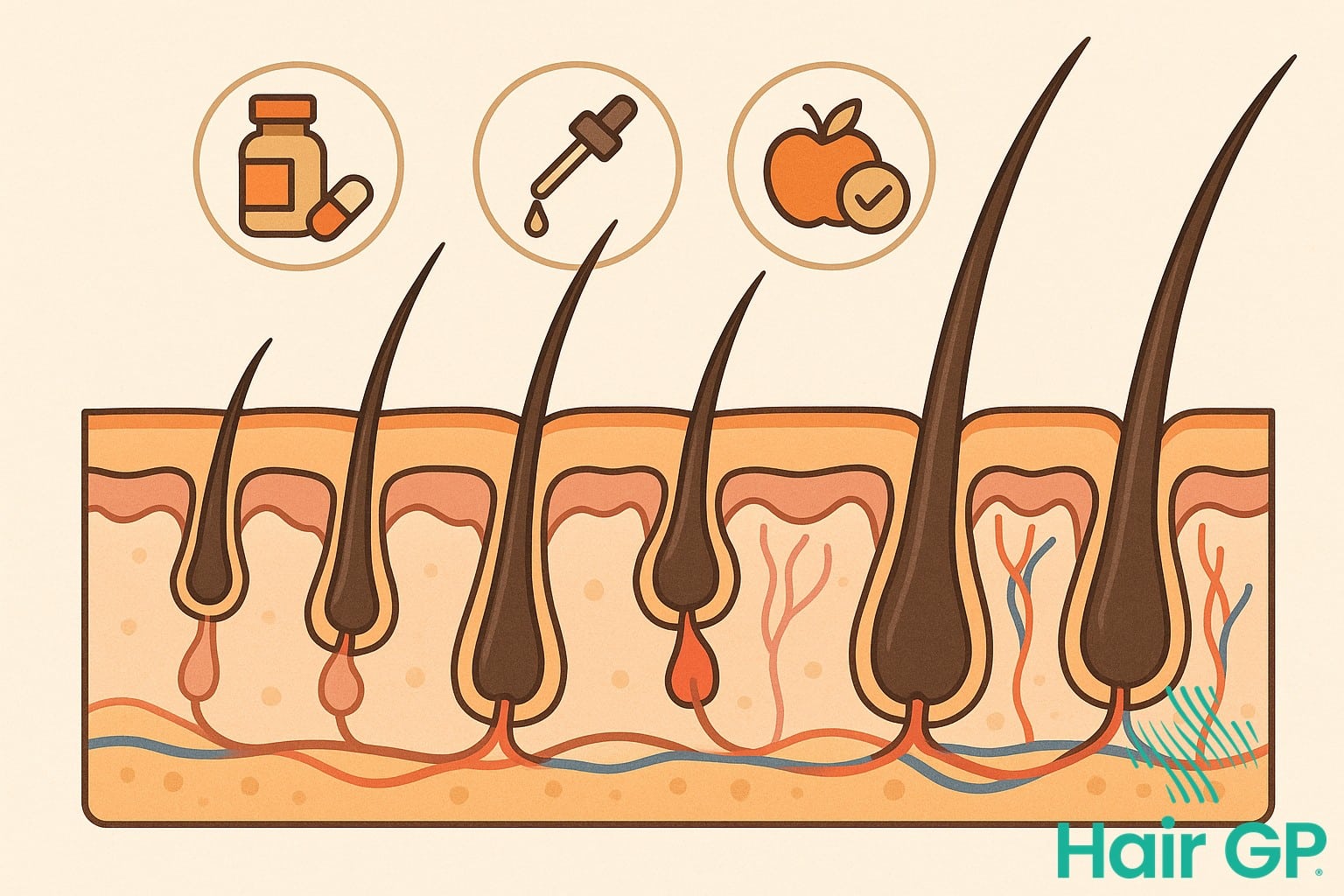
Phase 3: Recovery and Maintenance Strategy
As hormone levels stabilise post-menopause, many women discover an opportune time for hair recovery and establishing sustainable maintenance strategies. This phase focuses on rebuilding hair density through advanced regenerative treatments, developing manageable long-term care routines, and embracing the unique characteristics of postmenopausal hair whilst maintaining optimal health and appearance.
Regenerative Treatments
Advanced regenerative therapies offer promising options to stimulate hair growth and restore density in postmenopausal women. Platelet-rich plasma (PRP) therapy has emerged as a particularly effective treatment, with studies demonstrating significant improvements in hair density and thickness following a series of treatments[1]. The procedure involves drawing a small amount of blood, processing it to concentrate growth factors, and injecting the enriched plasma into the scalp. These growth factors help rejuvenate dormant follicles and promote hair regrowth by enhancing cellular regeneration and improving blood supply to hair roots.
Low-level laser therapy (LLLT) represents another evidence-based approach for stimulating follicular activity. Research indicates that specific wavelengths of red light can increase cellular metabolism within hair follicles, leading to improved hair regrowth over time[2]. Many women find home-use laser devices particularly convenient, allowing regular treatments without frequent clinic visits. The therapy works by enhancing mitochondrial function and increasing adenosine triphosphate production, which energises follicles and extends the growth phase of the hair cycle.
Microneedling, either alone or combined with topical treatments, offers an additional regenerative option. This technique creates controlled micro-injuries in the scalp, triggering the body’s natural healing response and increasing the absorption of growth-promoting substances. When performed professionally, microneedling can enhance the effectiveness of minoxidil and other topical treatments by up to five-fold, significantly improving outcomes for those seeking to restore healthy hair.
Long-term Maintenance Plan
Establishing a sustainable maintenance routine proves essential for preserving hair health throughout the postmenopausal years. A simplified approach focuses on consistency rather than complexity, recognising that adherence to basic practices often yields better results than sporadic intensive treatments. The cornerstone of long-term maintenance involves gentle cleansing twice weekly with sulphate-free shampoos, weekly deep conditioning treatments, and daily scalp massage to maintain circulation.
Quarterly assessments help track progress and identify necessary adjustments to your hair care regimen. During these evaluations, photograph your hair from multiple angles under consistent lighting, noting changes in density, texture, and overall appearance. This documentation proves invaluable for recognising gradual improvements and determining when product adjustments might benefit your evolving hair needs.
Product rotation and adjustment remain crucial as postmenopausal hair continues to change over time. What works effectively during the first year post-menopause may require modification as hair texture stabilises and new growth patterns emerge. Consider adjusting protein treatments based on hair elasticity, switching between moisturising and volumising products seasonally, and incorporating targeted treatments for specific concerns as they arise.
Embracing Your New Hair
Postmenopausal hair often develops unique characteristics that, when properly understood and styled, can become defining features of personal beauty. Many women discover their hair develops interesting texture variations, from gentle waves to defined curls, as hormonal influences shift. Learning to work with these natural patterns, rather than against them, often results in healthier, more manageable styles that celebrate individual character.
Grey hair care requires specific attention to maintain vibrancy and prevent yellowing. Purple-toned shampoos used weekly help neutralise brassy tones, whilst moisturising treatments prevent the dryness often associated with grey strands. Many postmenopausal women find that embracing their natural colour reduces chemical damage and allows hair to achieve optimal health and shine.
Building confidence with postmenopausal hair involves recognising that healthy hair at this life stage may look different from earlier years but possesses its own distinct beauty. Professional stylists experienced with mature hair can suggest cuts that maximise volume and movement whilst working with natural texture. The journey towards accepting and celebrating postmenopausal hair often leads to discovering styles that feel more authentic and require less daily manipulation, ultimately supporting long-term hair health and personal wellbeing.
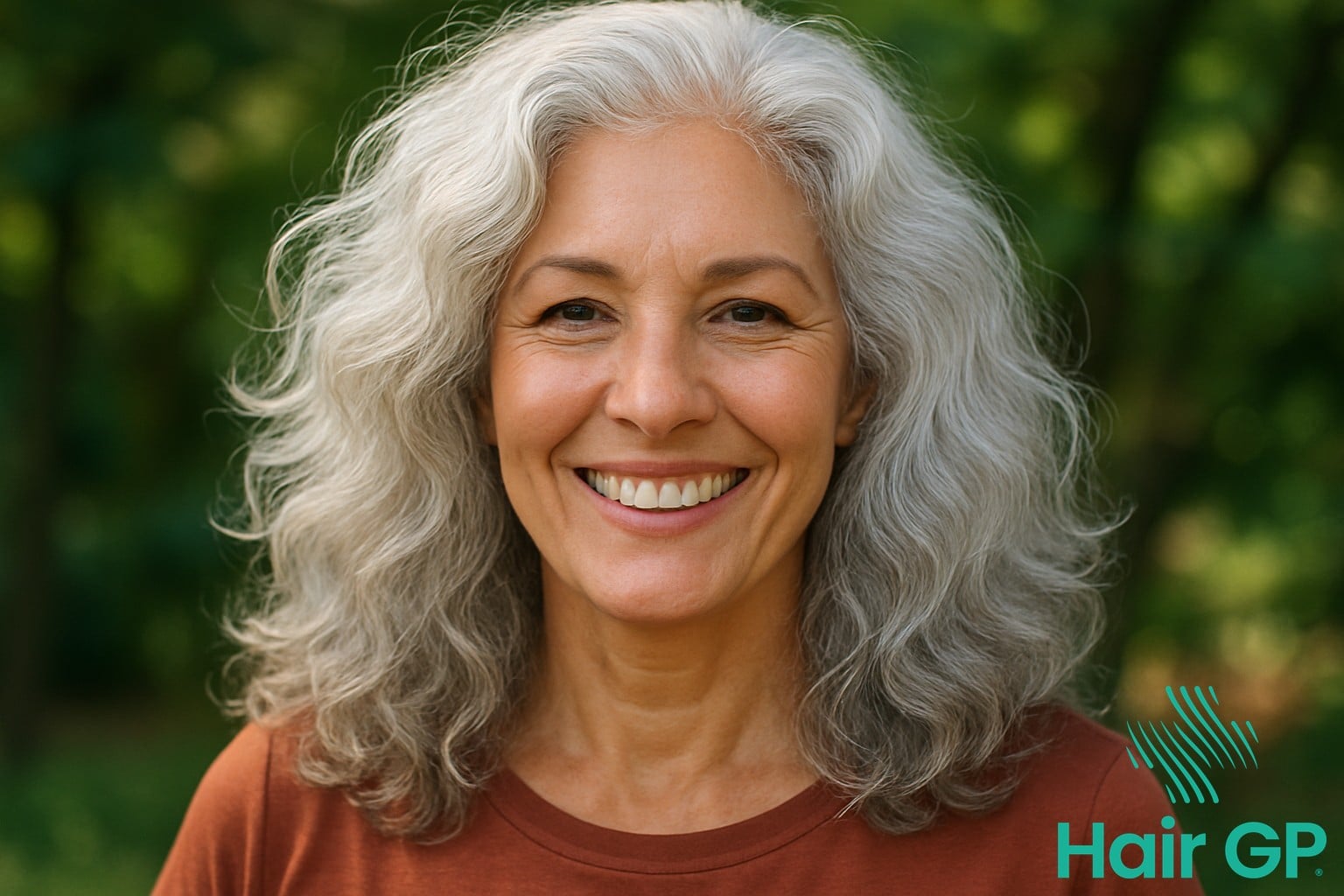
Essential Nutrients and Supplements for Each Phase
Targeted nutritional support plays a crucial role in maintaining healthy hair follicles throughout the menopausal transition. Strategic supplementation can help support hair growth by addressing the specific nutritional demands that arise during each phase, ensuring optimal nutrient availability for hair production and follicular health.
Core Supplements for All Phases
Several essential nutrients provide universal benefits throughout the entire menopausal journey, forming the foundation of hair health supplementation. The complete B-complex family, particularly vitamins B6, B12, and folate, work synergistically to support cellular metabolism within hair follicles and maintain healthy blood flow to the scalp.
Vitamin D emerges as another critical nutrient, with studies demonstrating its direct role in hair follicle cycling and regeneration. Menopausal women should aim for 1,000 IU daily, as vitamin D receptors in hair follicles regulate growth factors essential for the anagen phase [5]. Iron supplementation requires careful consideration, as deficiency commonly occurs during perimenopause due to irregular bleeding patterns. Maintaining ferritin levels above 70 ng/mL optimises hair production, though supplementation should be guided by blood tests to avoid excess accumulation [6].
Omega-3 fatty acids, particularly EPA and DHA found in fish oil supplements, provide anti-inflammatory benefits that protect follicles from oxidative stress. A daily dose of 1-2 grams helps maintain scalp health and supports the structural integrity of hair shafts [7]. These essential fatty acids also enhance blood flow to follicles, ensuring adequate nutrient delivery for optimal growth.
Phase-Specific Supplementation
During the early perimenopausal phase, antioxidant support becomes paramount as hormonal fluctuations increase oxidative stress. Vitamin C (500-1,000mg daily) and vitamin E (400 IU daily) work together to neutralise free radicals that can damage follicles. Selenium (55-70 mcg) and zinc (8-11mg) provide additional antioxidant protection whilst supporting thyroid function, which often becomes compromised during this transitional period.
As women enter peak menopause, amino acid supplementation gains importance for maintaining hair structure. L-cysteine (500mg twice daily) and L-methionine (500mg daily) serve as building blocks for keratin synthesis. These sulphur-containing amino acids are particularly crucial when dietary protein intake may be insufficient. Additionally, lysine supplementation (500-1,000mg daily) helps prevent excessive hair shedding by supporting collagen formation around follicles.
The recovery phase benefits significantly from collagen supplementation, as natural collagen production dramatically decreases post-menopause. Marine collagen peptides (5-10g daily) provide specific amino acids that support hair growth and improve hair diameter. Silicon supplements (5-10mg daily) enhance collagen synthesis and strengthen hair structure. MSM (methylsulfonylmethane) at 1,000-3,000mg daily provides organic sulphur necessary for keratin formation and helps maintain healthy hair follicles during this phase.
Timing supplementation for optimal absorption enhances effectiveness. Fat-soluble vitamins (A, D, E, K) should be taken with meals containing healthy fats, whilst water-soluble vitamins and minerals are best absorbed on an empty stomach or between meals. Separating iron from calcium supplements by at least two hours prevents absorption interference, maximising the benefits of each nutrient for hair health maintenance.
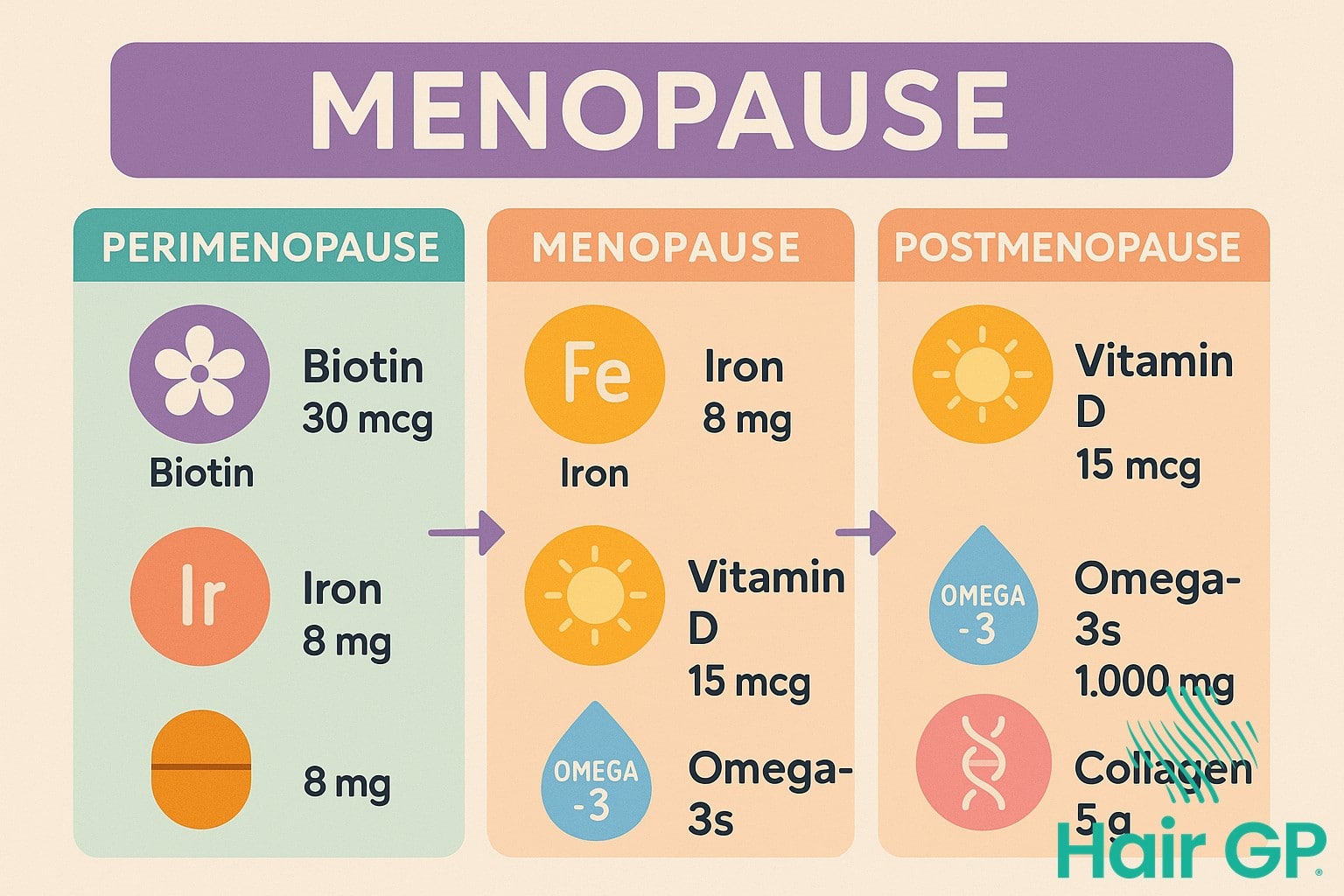
Lifestyle Factors Impacting Hair Health
Daily habits and lifestyle choices significantly influence hair health throughout menopause, with stress levels, physical activity, sleep patterns, and environmental exposures all playing crucial roles. Understanding how these factors interact with hormonal changes enables women to make informed decisions that support stronger, healthier hair during each menopausal phase.
Stress Management Techniques
Chronic stress represents one of the most significant factors that affect hair health during menopause, often leading to increased shedding and slower growth rates. When stress hormones like cortisol remain elevated, they disrupt the hair growth cycle, potentially triggering stress induced hair loss that compounds existing hormonal changes. This double impact can result in noticeable thinning, particularly around the crown and temples where hair follicles are most sensitive to hormonal fluctuations.
Evidence-based relaxation practices offer powerful tools for cortisol reduction and hair preservation. Daily meditation, even for just 10-15 minutes, has been shown to lower stress hormone levels and improve blood flow to the scalp. Progressive muscle relaxation, where tension is systematically released from different body parts, helps reduce the physical manifestations of stress that can contribute to brittle hair and scalp tension. Deep breathing exercises performed throughout the day provide immediate stress relief whilst improving oxygen delivery to hair follicles.
Creating consistent stress management routines becomes particularly important during perimenopause when hormonal fluctuations can intensify emotional responses. Journaling, gentle yoga, or spending time in nature all offer accessible ways to process emotions and reduce cortisol levels. Many women find that establishing evening wind-down rituals not only improves sleep quality but also reduces overnight hair breakage caused by stress-related teeth grinding or restless movement.
Exercise and Hair Health
Regular physical activity supports hair health through multiple mechanisms, from improving circulation to helping regulate hormones during menopause. Exercise increases blood flow to the scalp, delivering essential nutrients and oxygen to hair follicles whilst removing metabolic waste products. This enhanced circulation can help counteract the reduced blood flow that often accompanies ageing, supporting stronger hair growth from the roots.
Moderate aerobic exercise, such as brisk walking, swimming, or cycling, offers optimal benefits for hair strength without creating excessive stress on the body. These activities help balance hormones naturally whilst reducing inflammation that can damage hair follicles. Strength training twice weekly provides additional benefits by supporting healthy testosterone levels, which contribute to hair thickness and growth rate when properly balanced.
The timing and intensity of exercise matter during menopause. Excessive high-intensity training can elevate cortisol levels, potentially worsening hair loss, whilst gentle, consistent movement supports overall wellbeing. Many women find that morning exercise routines help regulate energy levels throughout the day and improve sleep quality at night, both factors that indirectly support healthier hair growth. Combining cardiovascular exercise with yoga or pilates provides comprehensive benefits, addressing both physical fitness and stress management simultaneously.
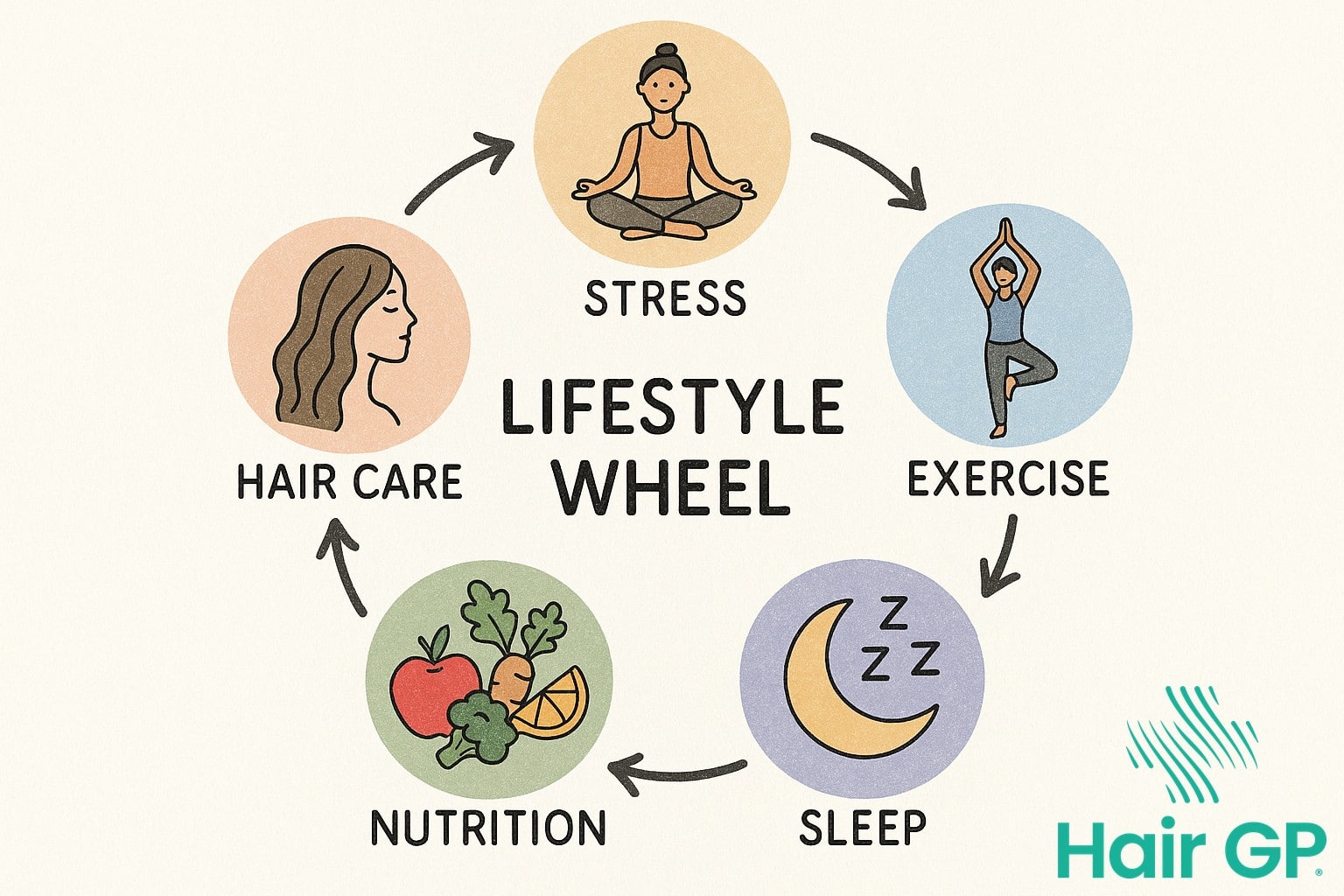
Professional Treatments and When to Seek Help
Understanding when to seek professional help for hair loss is crucial for effective treatment and preventing irreversible damage. Whilst many hair changes during menopause are normal, certain symptoms warrant immediate medical attention, and numerous specialised treatments can address various hair disorders when home remedies prove insufficient.
Warning Signs to Watch For
Rapid hair loss exceeding 150 strands daily or visible scalp patches developing within weeks requires urgent dermatological evaluation. Unlike gradual thinning associated with female pattern baldness, sudden shedding may indicate underlying medical conditions requiring prompt intervention. Scalp inflammation presenting as redness, burning sensations, or persistent itching accompanied by hair loss suggests inflammatory alopecia conditions that can cause permanent follicle damage without treatment.
Patchy baldness appearing as smooth, round areas differs from typical menopausal thinning patterns. These patches, characteristic of alopecia areata, require specialist assessment as they indicate autoimmune involvement. Additionally, a receding hairline progressing rapidly or asymmetrically warrants professional evaluation, as not all hair loss stems from hormonal changes. Other concerning signs include scalp pain, unusual scaling, or hair breaking at the scalp level rather than falling from the root.
Available Medical Treatments
Prescription medications offer evidence-based solutions for androgenic alopecia and other menopausal hair loss conditions. Minoxidil (5% formulation for women) remains the gold-standard topical treatment, promoting regrowth in 60-80% of cases when used consistently. Oral medications including spironolactone and finasteride address hormonal imbalances driving hair loss, though require careful monitoring and aren’t suitable for all patients.
Injection therapies provide targeted intervention for stubborn cases. Platelet-rich plasma (PRP) treatments involve injecting concentrated growth factors from your blood into affected scalp areas, stimulating dormant follicles. Corticosteroid injections effectively treat inflammatory alopecias and alopecia areata, reducing immune attacks on hair follicles. Mesotherapy, combining vitamins and medications in micro-injections, improves scalp circulation and nutrient delivery.
Surgical options represent advanced interventions for permanent hair loss. Hair transplantation techniques, including follicular unit extraction (FUE) and strip harvesting, relocate healthy follicles to thinning areas. Scalp micropigmentation offers a non-surgical alternative, creating the appearance of fuller hair through specialised tattooing. Low-level laser therapy devices, available in clinical and home-use versions, stimulate cellular activity in weakened follicles.
Specialist consultations typically involve comprehensive scalp examination, detailed medical history, and diagnostic tests including blood work and sometimes scalp biopsies. Doctors specialising in hair loss can identify specific conditions and create personalised treatment plans combining multiple approaches for optimal results.
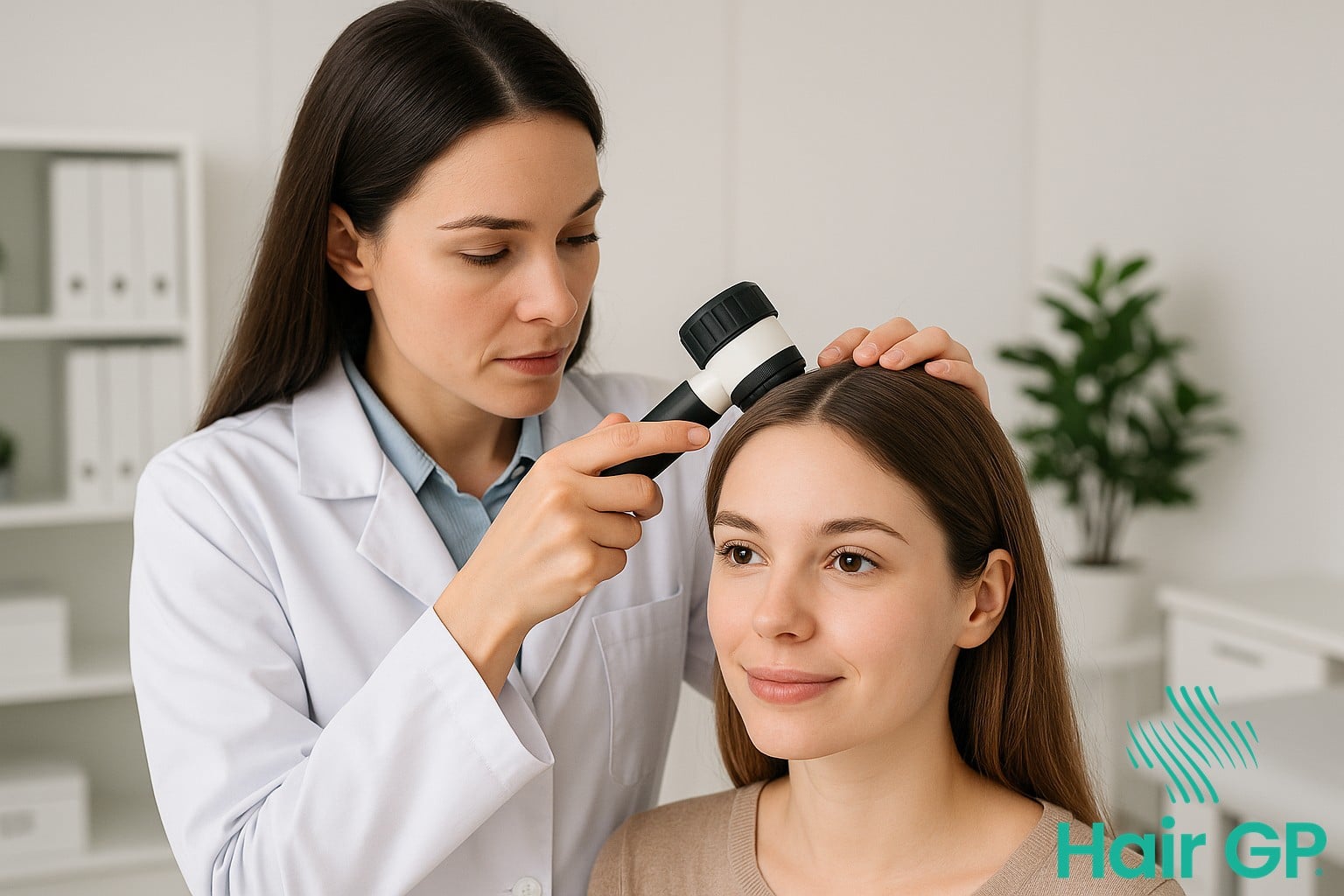
Creating Your Personalised Hair Care Routine
Developing a personalised hair care routine tailored to your specific menopausal phase and hair needs is essential for managing changes effectively. This step-by-step guide helps you create a customised approach that addresses your unique hair type, loss patterns, and individual requirements, ensuring optimal results through targeted product selection and technique optimisation.
Assessing Your Hair Type and Needs
Understanding your current hair condition forms the foundation of an effective hair care routine. Begin with a simple hair porosity test by placing a clean, dry strand in a glass of water. If it floats, you have low porosity hair that resists moisture; if it sinks slowly, you have normal porosity; and if it sinks quickly, your hair has high porosity and may be damaged. This information guides product selection, as high-porosity hair requires heavier, protein-rich treatments, whilst low-porosity hair benefits from lightweight, heat-activated products.
Density assessment involves examining how much scalp is visible when your hair is styled normally. For menopausal women experiencing hair thinning, documenting changes through monthly photographs helps track progress. Part your hair in several locations and note areas where thinner hair is most apparent. This mapping allows you to focus treatments on specific zones requiring extra attention.
Evaluate damage by examining your hair’s texture and elasticity. Gently stretch a wet strand; healthy hair stretches and returns to its original length, whilst damaged hair breaks easily or remains stretched. Look for signs of chemical damage, heat styling effects, or environmental stress. Understanding these factors helps you adjust your routine to address specific concerns whilst preventing further damage during this vulnerable period when hair falls out more readily.
Building Your Morning Routine
Your morning routine sets the foundation for daily hair protection and health. Begin with gentle cleansing using lukewarm water and sulphate-free shampoo, focusing on the scalp rather than the lengths. For those experiencing increased hair shedding, limit washing to 2-3 times weekly to preserve natural oils that protect fragile strands. When cleansing, use fingertips rather than nails to massage the scalp in circular motions, avoiding aggressive scrubbing that can worsen hair loss.
Incorporate scalp stimulation through gentle massage for 3-5 minutes daily. This practice increases blood circulation to follicles, supporting healthier growth whilst providing stress relief. Use a soft-bristled brush or specialised scalp massager, working from the hairline backwards in smooth, consistent strokes. This technique is particularly beneficial for menopausal women, as it helps counteract reduced circulation that contributes to hair thinning.
Protective styling becomes crucial when dealing with fragile hair. Choose loose, low-manipulation styles that minimise tension on the scalp. Avoid tight ponytails, buns, or braids that can cause traction alopecia. Instead, opt for soft scrunchies, claw clips, or loose plaits. Apply a leave-in conditioner or heat protectant before styling, concentrating on mid-lengths and ends where damage accumulates most readily.
Evening Hair Care Practices
Nighttime routines focus on repair and protection whilst you sleep. Apply overnight treatments once or twice weekly, choosing formulations that address your specific concerns. For dry, brittle hair, use nourishing oil treatments; for thinning areas, consider specialised serums containing peptides or growth factors. Apply treatments to clean, damp hair, focusing on the scalp and working through to the ends.
Silk pillowcases represent a worthwhile investment for anyone experiencing hair fragility. The smooth surface reduces friction that causes breakage and tangles, whilst silk’s natural properties help maintain hair moisture levels overnight. This simple change can significantly reduce morning tangles and the associated hair loss from combing.
Protective hairstyles for sleep prevent unnecessary stress on vulnerable strands. Loosely braid long hair or secure it in a soft, high bun using a silk scrunchie. For shorter styles, consider a silk bonnet or wrap to minimise friction and preserve your style. These practices become especially important as hormonal changes make hair more prone to breakage during the menopausal transition.
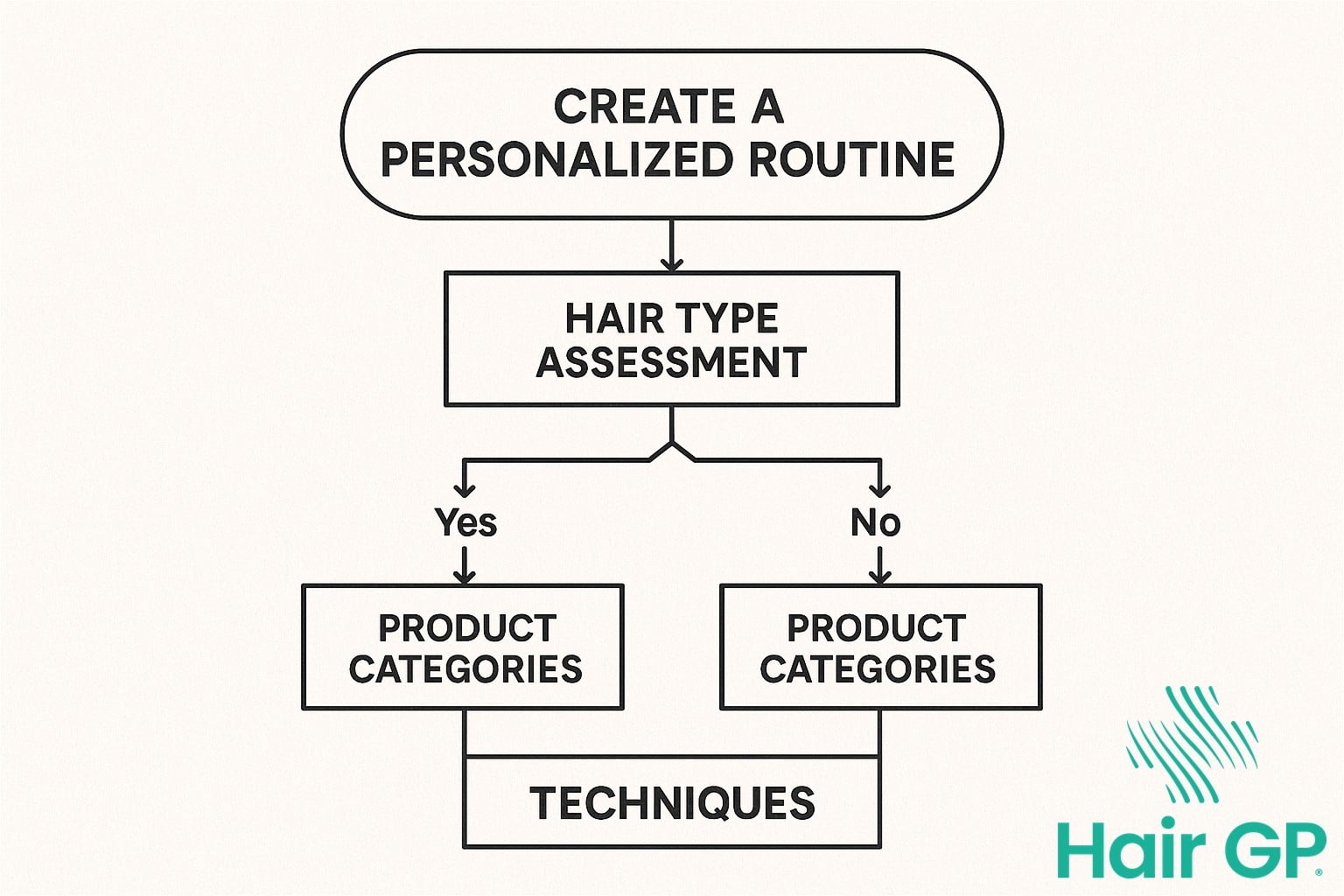
Natural Remedies and Alternative Approaches
Natural remedies offer gentle yet effective approaches to support hair health during menopause, with several evidence-based options showing promise for managing hair loss. Whilst these alternatives shouldn’t replace conventional treatments, they can complement your overall hair care strategy and help stimulate hair growth naturally.
Essential oils have emerged as particularly promising natural solutions for promoting hair growth. Rosemary oil has demonstrated effectiveness comparable to minoxidil in clinical studies, with research showing it can improve hair count after six months of use [8]. Similarly, peppermint oil has shown remarkable results in animal studies, increasing the number of hair follicles, follicle depth, and overall hair growth [9]. When using essential oils, always dilute them with carrier oils like jojoba or coconut oil before applying to the scalp to prevent irritation.
Scalp massage represents another evidence-based approach that can enhance blood flow to hair follicles. Regular massage techniques have been shown to increase hair thickness by stretching the cells of hair follicles and potentially activating genes related to hair growth [10]. Dedicating just five minutes daily to gentle circular motions across the scalp can improve circulation and create an optimal environment for healthy hair growth whilst potentially reducing stress levels that contribute to further hair loss.
Herbal remedies traditionally used for hair health include saw palmetto, which may block hormones linked to hair loss, and ginseng, believed to stimulate growth factors within follicles. Green tea extracts, rich in antioxidants, can be applied topically or consumed to support overall hair health. Whilst research continues to explore these options, many women report positive results when incorporating them into their routines.
Nutritional approaches focusing on specific vitamins and minerals can address deficiencies common during menopause. Iron, biotin, vitamin D, and omega-3 fatty acids play crucial roles in maintaining healthy hair growth cycles. However, it’s essential to consult healthcare providers before starting any supplement regimen, as excessive doses can sometimes worsen hair loss or interact with other medications.
Creating a holistic approach combining these natural remedies with stress reduction techniques, adequate sleep, and proper nutrition often yields the best results. Remember that natural remedies typically require consistent use over several months to show benefits, and individual responses vary considerably based on underlying causes of hair loss and overall health status.
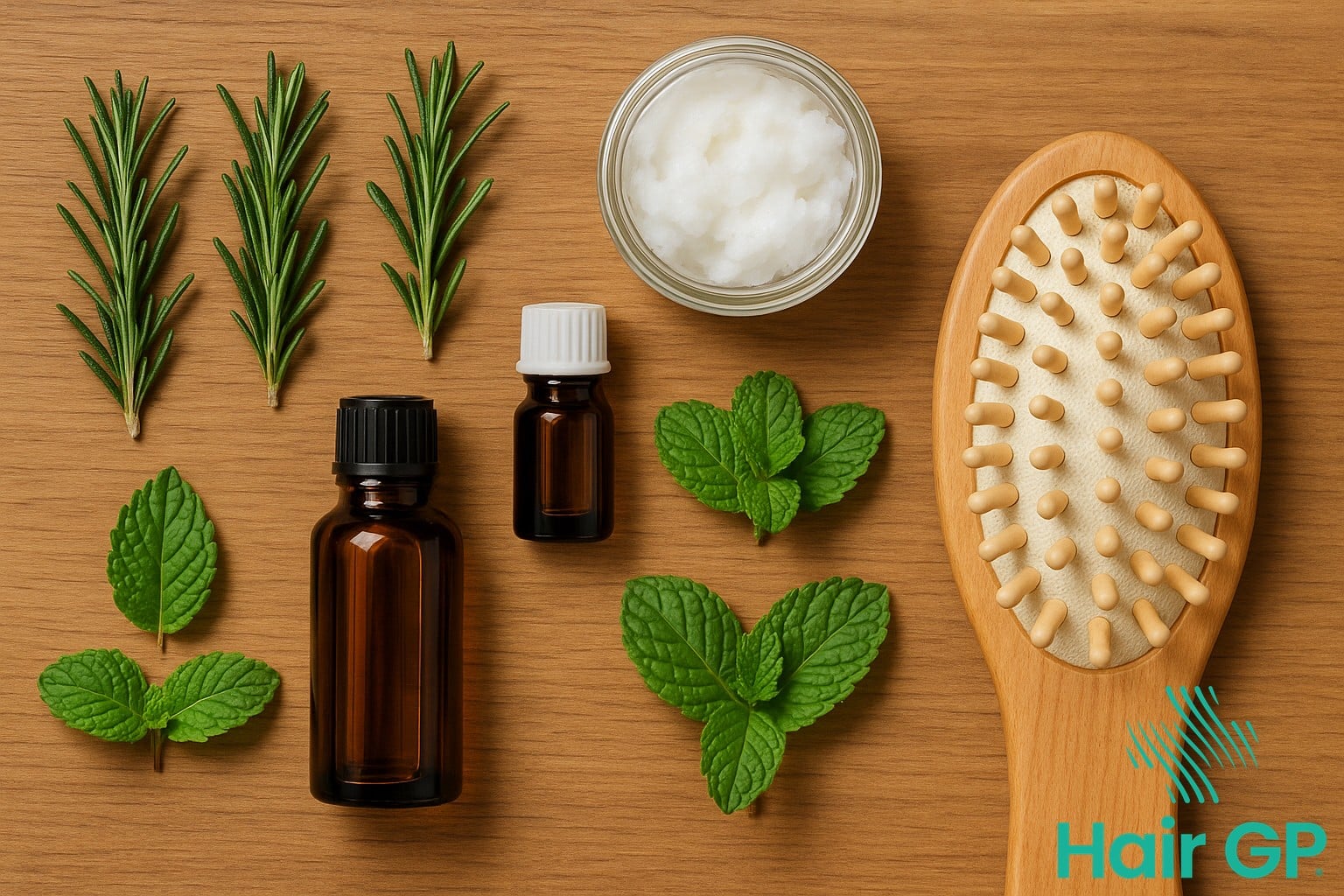
Tracking Progress and Adjusting Your Strategy
Monitoring your hair health journey requires patience and a systematic approach, particularly during the menopausal transition when changes occur gradually. Begin by establishing a baseline through monthly photographs taken under consistent lighting and angles. Document the crown, temples, and overall hair density from multiple perspectives, storing these images in a dedicated folder for easy comparison. Additionally, maintain a simple journal noting any changes in texture, shedding patterns, or scalp sensations alongside your current treatments and lifestyle factors.
Understanding progress indicators helps you recognise whether your strategy is working effectively. Positive signs include reduced hair fall during washing and brushing, the appearance of baby hairs along the hairline indicating new hair growth, and improved texture or thickness when running your fingers through your hair. Hair regrowth typically follows a predictable pattern: initial reduction in shedding occurs within 4-6 weeks, followed by visible new growth at 3-4 months, with significant improvements in hair density becoming apparent after six months of consistent treatment.
Knowing when to adjust your approach is crucial for optimal results. If you haven’t noticed any positive changes after three months, consider modifying your strategy. This might involve switching hair care products, incorporating additional nutritional supplements, or addressing underlying stress factors that could be impacting hair production. Pay attention to how your hair responds to seasonal changes, hormonal fluctuations, and lifestyle adjustments, as these factors often necessitate tweaks to your routine.
Remember that hair health improvement is rarely linear, especially during menopause. Some months may show dramatic progress whilst others appear stagnant. Focus on overall trends rather than daily fluctuations, reviewing your documentation quarterly to assess whether your current approach remains effective. If progress plateaus after initial improvements, consider rotating treatments or combining different approaches to stimulate renewed growth. Most importantly, celebrate small victories along the way – each new strand represents your body’s remarkable ability to regenerate, even during significant hormonal changes.

Common Mistakes to Avoid During Each Phase
Understanding what to avoid during your hair loss journey is just as crucial as knowing what to do. Many well-intentioned actions can inadvertently cause hair breakage or accelerate hair shedding, particularly during vulnerable phases of recovery. One of the most common early-phase mistakes is over-washing or using harsh shampoos in an attempt to keep the scalp ‘extra clean’. This strips natural oils and can weaken hair strands, leading to increased hair falls during brushing and styling. Instead, maintain a gentle cleansing routine with sulphate-free products designed for thinning hair.
During active treatment phases, many individuals make the error of switching between treatments too quickly or combining multiple therapies without professional guidance. This impatience can trigger further hair loss and irritate the scalp, disrupting the natural growth cycle. It’s essential to give each treatment at least three to four months before evaluating results, as hair growth is a gradual process. Additionally, aggressive styling techniques like tight ponytails, excessive heat styling, or chemical treatments should be avoided as they can cause mechanical stress and breakage to already fragile hair.
The recovery phase brings its own set of potential pitfalls. A significant mistake is discontinuing treatments too early when initial improvements appear. Hair regrowth requires consistent support, and premature cessation can result in renewed shedding. For those experiencing menopausal symptoms, overlooking the connection between hormonal changes and hair health is another critical error. Hormone-related hair loss requires specific approaches, and failing to address underlying hormonal imbalances can hinder recovery efforts.
Lifestyle mistakes that span all phases include inadequate nutrition, chronic stress, and poor sleep habits. Many people focus solely on topical treatments whilst neglecting these foundational elements that prevent hair loss from within. Crash dieting is particularly harmful, as sudden caloric restriction can push more follicles into the shedding phase. Similarly, excessive supplementation without proper testing can create imbalances that worsen hair loss rather than improve it. The key is maintaining a balanced approach that addresses both external care and internal health, whilst being patient with the natural timeline of hair recovery. Remember, sustainable improvements take time, and avoiding these common mistakes will significantly enhance your chances of successful hair restoration.
Conclusion
The journey through menopausal hair loss doesn’t have to feel overwhelming. By understanding and implementing this three-phase strategy, you can take control of your hair health and work towards restoring the healthy hair you desire. Whether you’re experiencing early signs of female pattern hair loss or seeking to reverse existing changes, remember that progress is possible with consistent effort and the right approach.
Phase one provides immediate relief whilst you build your foundation. Phase two addresses the root causes affecting hair growth through targeted nutrition and lifestyle modifications. Phase three ensures long-term maintenance of your results, helping you sustain the improvements you’ve achieved. Each phase builds upon the previous one, creating a comprehensive system for managing menopausal hair changes effectively.
The key is to start where you are today. You don’t need to implement everything at once. Choose one or two strategies that resonate with you and gradually incorporate others as you build confidence. Many women have successfully navigated this challenge, and with patience and persistence, you can too. Your hair health journey is unique, but with these evidence-based strategies, you’re equipped to face menopausal hair loss with knowledge, tools, and hope for healthier, fuller hair ahead.
Frequently Asked Questions
The duration varies by individual, but generally: Early phase (perimenopause) can last 4-8 years, Peak phase (menopause transition) typically spans 1-2 years around the final menstrual period, and Recovery phase begins in postmenopause and continues indefinitely. Your genetics, overall health, and treatment adherence all influence timeline.
While you cannot prevent all hair changes during menopause due to inevitable hormonal shifts, following a comprehensive strategy can significantly minimise hair loss and maintain better hair density. Studies show that women who implement preventive measures during perimenopause experience 40-60% less hair loss than those who don’t.
Yes, much of menopausal hair loss is reversible, especially when addressed early. Hair miniaturization can often be reversed with proper treatment, and the telogen effluvium component typically resolves as hormones stabilise. However, genetic pattern hair loss (androgenetic alopecia) may require ongoing management.
Begin the early phase strategy as soon as you notice perimenopausal symptoms, typically in your 40s. Signs include irregular periods, mood changes, or subtle hair texture changes. Starting preventive measures before significant hair loss occurs yields the best long-term results.
While no single supplement is universally most important, iron (for those deficient), vitamin D, and biotin form the foundation. However, a comprehensive approach including omega-3s, B-complex vitamins, and adequate protein typically produces better results than focusing on one supplement alone.
References
- Santoro N, Roeca C, Peters BA, Neal-Perry G. The Menopause Transition: Signs, Symptoms, and Management Options. J Clin Endocrinol Metab. 2021. PMID: 33095879
- Grymowicz M, Rudnicka E, Podfigurna A, Napierala P, Smolarczyk R, Smolarczyk K et al.. Hormonal Effects on Hair Follicles. Int J Mol Sci. 2020. PMID: 32731328
- Messenger AG, Rundegren J. Minoxidil: mechanisms of action on hair growth. Br J Dermatol. 2004. PMID: 14996087
- Mirmirani P. Hormonal changes in menopause: do they contribute to a 'midlife hair crisis' in women? Br J Dermatol. 2011. PMID: 22171679
- Gerkowicz A, Chyl-Surdacka K, Krasowska D, Chodorowska G. The Role of Vitamin D in Non-Scarring Alopecia. Int J Mol Sci. 2017. PMID: 29215595
- Trost LB, Bergfeld WF, Calogeras E. The diagnosis and treatment of iron deficiency and its potential relationship to hair loss. J Am Acad Dermatol. 2006. PMID: 16635664
- Le Floc'h C, Cheniti A, Connétable S, Piccardi N, Vincenzi C, Tosti A. Effect of a nutritional supplement on hair loss in women. J Cosmet Dermatol. 2015;14(1):76-82. PMID: 25573272
- Panahi Y, Taghizadeh M, Marzony ET, Sahebkar A. Rosemary oil vs minoxidil 2% for the treatment of androgenetic alopecia: a randomized comparative trial. Skinmed. 2015;13(1):15-21. PMID: 25842469
- Oh JY, Park MA, Kim YC. Peppermint Oil Promotes Hair Growth without Toxic Signs. Toxicol Res. 2014;30(4):297-304. PMID: 25584150
- Koyama T, Kobayashi K, Hama T, Murakami K, Ogawa R. Standardized Scalp Massage Results in Increased Hair Thickness by Inducing Stretching Forces to Dermal Papilla Cells in the Subcutaneous Tissue. Eplasty. 2016. PMID: 26904154

